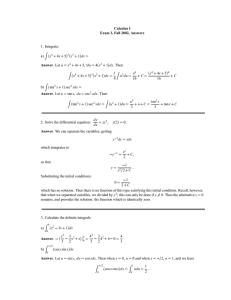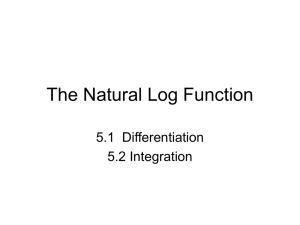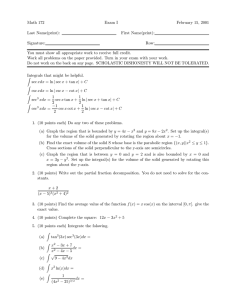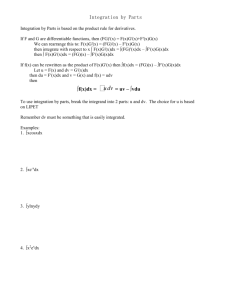Document 11741040
advertisement
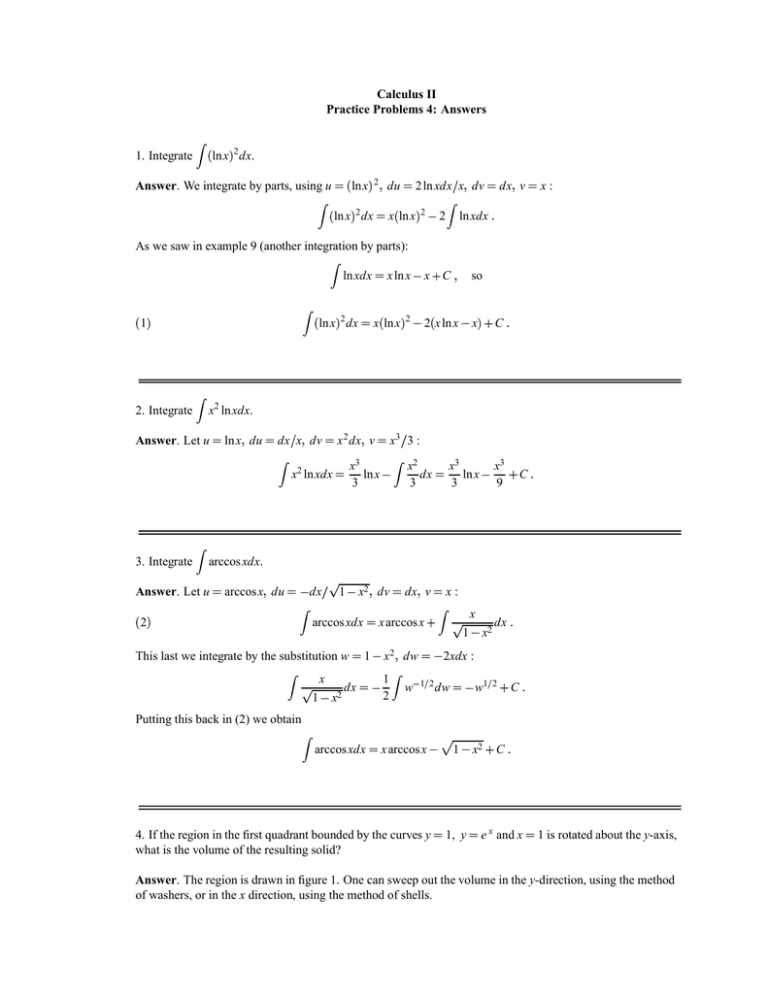
Calculus II Practice Problems 4: Answers 1. Integrate ln x 2 dx. du 2 ln xdx x dv dx v ln x dx x ln x 2 ln xdx Answer. We integrate by parts, using u 2 ln x 2 x: 2 As we saw in example 9 (another integration by parts): x C so ln x dx x ln x 2 x ln x x C ln xdx 1 2. Integrate x ln x 2 2 x2 lnxdx. Answer. Let u ln x du x 2 dx v dx x dv x2 ln xdx 3. Integrate x3 ln x 3 x3 3 : x2 dx 3 x3 ln x 3 x3 9 C arccos xdx. dx 1 x dv dx v x : x 2 arccosxdx x arccosx 1 x dx This last we integrate by the substitution w 1 x dw 2xdx : x 1 1 x dx 2 w dw w C Answer. Let u 2 arccosx du 2 2 1 2 1 2 2 Putting this back in (2) we obtain arccosxdx x arccosx 1 4. If the region in the first quadrant bounded by the curves y what is the volume of the resulting solid? 1, y x2 C e x and x 1 is rotated about the y-axis, Answer. The region is drawn in figure 1. One can sweep out the volume in the y-direction, using the method of washers, or in the x direction, using the method of shells. 3.5 3 2.5 2 1.5 1 0.5 0 0 PSfrag replacements 0.2 0.4 0.6 0.8 1 1.2 Figure 1 Washers. Here, sweeping in the y direction, the differential of volume is dV radius is R 1, and the smaller radius is r ln y. Thus Volume π e 1 1 lny dy π y y lny 2 2 e using the solution to problem 1 above (equation (1)). Then Volume π e 2e 2e 2y ln y 1 2 π 1 2π 0 1 dx x ex 2π xex ex x2 2 π R2 2y Shells. Now, we sweep out along the x-axis, and the differential of volume is dV and the height of the shell is e x 1. Thus Volume r dy. 2 The larger e 1 2π rhdx. The radius is x, 1 0 using the formula obtained in example 5 of the Notes. We get Volume 5. Integrate 1 e 0 1 2 2π e π sec3 xdx. 1 tan x: 3 sec udu tan x 1 secxdx tan x sec xdx sec xdx in example 3 of the notes, so we concentrate on the first integral. If we The last integral was computed write tan x sec xdx tan x sec x tan x dx, then we can integrate by parts with the substitution u tan x du sec xdx dv sec x tan xdx v sec x. Then tan x sec xdx sec x tan x sec xdx Answer. First, we use the identity sec 2 x 3 2 2 2 2 2 2 3 It appears we’re back where we started, but not exactly. Substitute this in (3) to get: sec3 udu sec x tan x sec3 xdx sec xdx Moving the second term to the left hand side, and dividing by 2, we have the result sec3 udu 1 sec x tan x 2 sec xdx 1 sec x tan x 2 Incicentally, the expression found in example 3 of the Notes for to the formula found in most integral tables: 4 sec xdx using this sequence of identities: ln 1 1 sinx sinx 2 ln ln ln sec x 1 1 1 1 ln 4 1 tanx C C ln 1 sin x cos x 1 cossinx x sinx sinx sec xdx is not the usual one, but is equivalent sinx 2 sin2 x 2 ln sec x tanx 2 Finally, this gives the answer to our problem: 5 sec3 udu ln sec x 1 sec x tan x 2 tanx C Answer. For part (a), we seek constants A B such that x 1 A B x x 3 x x 3 6. Integrate (a) x 1 dx (b) xx 3 x 1 dx x2 x 3 2Bx. 3. Put the right hand side over a common denominator and equate numerators, getting x 1 A x 3 Now substituting x 0, we get 1 3A, so A 1 3. Substitute x 3 to get 3 1 B 3 , so B Thus x 1 dx 1 dx 2 dx 1 2 1 ln x 3 C ln x x 3 2 C ln x xx 3 3 x 3 x 3 3 3 3 For part (b), we seek constants A B C such that x2 x 1 x 3 A x B x2 x C 3 Put the right hand side over a common denominator and equate numerators, getting x 1 Ax x 3 B x 3 Cx2 . Now substituting x 0, we get 1 3B, so B 1 3. Substitute x 3 to get 3 1 C 9 , so C 2 9. That uses up the roots, so to find A we have to equate coeffiecients. Equating the coefficients of x2 we get 0 A C, so A 2 9. Now, we can integrate: x 1 dx x2 x 3 7. Integrate dx x 1 x 2 2 9 dx x 2 . 1 3 dx x2 2 9 dx x 3 2 ln x 9 1 x 3 1 2 ln x 9 3 C 1 x A 1 x B 2 x C2 x 1 x 2 side over a common denominator Put the right hand and equate numerators, getting 1 A x 2 B x 1 x 2 C x 1 . Substitute x 1: 1 A 9 , so A 1 9. Substitute x 2: 1 C 3 , so C 1 3. Now equate coefficients of x : 0 A B, so B 1 9. Thus 1 9 dx 1 9 dx dx 1 3 dx x 1 x 2 x 1 x 2 x 2 19 ln xx 12 13 x 2 C x 1 dx . 8. Integrate x 1 x 3 Answer. We seek constants A B C such that x 1 A Bx C x 1 x 3 x 1 x 1 x 3 Put the right hand side over a common denominator and equate numerators, getting x 1 A x 3 ! Bx x 3 " C x 1 . Substitute x 3 to get 3 1 C 3 1 , giving C 4 5. To find A and B we must equate coefficients. For the constant term this gives 1 3A C, so A 3 5. Equating coefficients of x gives us 0 A 3B, so B A 3 1 5. Thus x 1 dx 3 dx 1 xdx 4 dx x 1 x 3 5 x 1 5 x 1 5 x 3 35 arctanx 101 ln x 1 45 ln x 3 C Answer. We seek constants A B C such that 2 2 2 2 2 2 1 2 2 2 2 2 2 2 2 2 2 2 2 2 2 2 x2 dx . 9 x Answer. We use the substitution indicated in figure 2. Then 9. Integrate 2 x 3 sin u dx 3 cos udu 9 x2 3 cos u 3 x PSfrag replacements u 9 Figure 2 x2 The integral becomes xdx 1 2 9 sin2 u 3 cos udu 9 3 cosu 9 x2 This integral requires the half-angle formula; using that we obtain: sin2 udu so 1 xdx 9 # 1 u 2 cos 2u du 9 u 2 1 sin 2u 2 sin2 udu 1 sin 2u 2 C C x2 Now, to express this in terms of x, we need the double angle formula sin 2u 9 92 arcsin 3x x 99 x C 2 sin u cosu, giving finally: 2 xdx x2 x2 dx . 9 x Answer. We use the substitution indicated in figure 3. 10. Integrate 2 9 x2 x PSfrag replacements u 3 Figure 3 Then x 3 tanu and the integral becomes x2 dx 9 x2 We calculate this integral by parts: v dx 3 sec 2 udu 9 tan2 u 3 sec2 udu 3 sec u tan u sec u 1 sec u tanu ln sec u 2 x2 9 tan u sec u tanu C 3 sec u tan2 u sec2 udu sec 2 udu dw tan u dv tan2 u sec2 udu 9 sec u tan udu w x2 dx 9 x2 9 2 9 x2 x 3 3 1 x 2 9 1 sec u tanu 2 ln sec u ln 9 x x C 3 3 x2 2 9 x C 9 ln x 2 sec u: sec3 udu Resubstituting back, to get an expression in terms of x: x2 dx 9 x2 2 or tan u C
